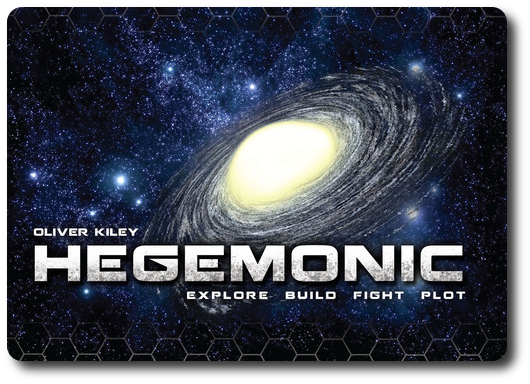
The Basics:
- For ages 13 and up
- For 2 to 6 players
- Approximately 45 minutes per player to complete
Geek Skills:
- Active Listening & Communication
- Counting & Math
- Logical & Critical Decision Making
- Reading
- Pattern/Color Matching
- Strategy & Tactics
- Risk vs. Reward
- Visuospatial Skills
- Hand/Resource Management
- Worker Placement & Area Control
Learning Curve:
- Child – Hard
- Adult – Moderate
Theme & Narrative:
- Dominate the galaxy through political, industrial, and martial might!
Endorsements:
- Gamer Geek mixed!
- Parent Geek rejected!
- Child Geek rejected!
Overview
Peace throughout the galaxy was maintained by a powerful few, but nothing lasts forever. When the great leaders passed, the ideals they attempted to instill in their people began to fade. The allure of the unknown and the promise of riches on other worlds became too tempting to ignore. Galactic calm has been replaced by bitter strife. Allies wage political battles while warring space fleets explode in the vacuum of space. Lead your people to their destiny or their doom.
Hegemonic, designed by Oliver Kiley and published by Minion Games, is comprised of 1 Galactic Core board, 9 Galaxy boards, 48 Sector hex tiles, 6 Starting Sector hex tiles, 90 Industrial Complexes (15 each of 6 colors), 54 Political Embassies (9 each of 6 colors), 72 Martial Outposts (12 each of 6 colors), 18 Fleets (3 each in 6 colors), 18 Agents (3 each in 6 colors), 18 Quantum Gate pairs (3 pairs each of 6 colors), 6 double-layered Player boards, 36 Action cards (6 sets of 6 with one set per player), 81 CAP tokens (money), 54 Resolution/Technology cards, 12 Leader cards (used in game variant), 1 Arbiter token, 1 Phase Tracker token, 1 Score board, 12 Score Track tokens, and 6 Player Aids. The game component quality and durability is excellent with detailed plastic pieces and clean artwork. Of special note are the Player boards that have small sunken spaces that hold in place the Political Embassies, Martial Outposts, and Industrial Complexes. There are also spots for the Fleets, Agents, and cards. Excellent stuff.
Game Set Up
To set up the game, first place the Galactic Core board in the middle of the playing area and then build the rest of the galaxy using the Sector Galaxy boards. The placement of the Sector Galaxy boards and the number used is dependent on the number of players in the game. Examples are provided in the game’s rule book.
Second, each player chooses one of the six colors and takes all the game pieces in that specific color, a Home Sector hex tile, a Player board, and all the Action cards that match the color of the player’s pieces. The Player board should be placed in front of the player now and all but 2 Industrial Complexes will be placed in the corresponding spaces for the player’s Industrial Complexes, Martial Outposts, Political Embassies, Fleets, and Agents.
Third, take the Score board and place it to one side of the game playing area. Each player should now place their 2 Industrial Complexes not placed on their Player board next to the “Start” on the Score board. One of the two Industrial Complexes will be used to keep track of score values 1 through 49 and the other will keep track of the 50, 100, and 150 score values.
Fourth, take the Technology cards and remove any cards that should not be used depending on the number of players in the game. Shuffle the remaining Technology cards and deal 5, face-down, to each player. The remaining Technology cards should be placed, face-down, to one side of the game playing area. This is the Technology draw deck for the duration of the game. Leave room next to the Technology draw deck for a discard pile.
Fifth, take the Sector hex tiles and remove any that should not be used depending on the number of players in the game. Shuffle the remaining Sector hex tiles and deal 2 to each player. The remaining stack of Sector hex tiles should be placed, face-down, to one side of the game playing area. This is the Sector draw stack for the duration of the game.
Sixth, determine which player will be the initial Arbiter and hand them the Arbiter token. Starting with the Arbiter and going clockwise, each player places their Home Sector. When it’s the Arbiter’s turn again, each player will now place one of their two Sector hex tiles adjacent to their Home Sector. The Sector hex tile not used is placed, face-up, next to the Sector draw stack. This is the Sector pool for the duration of the game.
Seventh, each player now places 1 Political Embassy, 1 Martial Outpost, and 1 Industrial Complex from their Player board to their Home Sector.
Seventh, place the Phase Tracker token on the “1” in the middle of the Galactic Core board and the CAPs in a pool off to one side. I suggest you make one player the “Banker” to help facilitate smooth game play.
The game is now ready to play!
Galactic Conquest
Note: Hegemonic is not a difficult game once you learn how to play it, but there are a lot of steps and decisions to make along the way. The overall learning curve for the game is moderate to hard, depending on the player’s experience. I have summarized the game play here to keep this review to a reasonable length and highly encourage you to refer to the rule book for additional details. The rule book can be a bit vague at times, but the sidebar included in the rule book provides visual examples that often clear up any language ambiguity. Much of the game can be learned by simply reading the rule book, but the game won’t make sense until you see it played out in front of you. This is due, in part, to the game’s abstract game play.
Hegemonic is played in rounds with no set number of rounds per game. Each round is broken down into 6 phases which are tracked using the Phase Tracker token. A round and each phase is summarized here.
Phase 1: Collection
The first phase, starting with the Arbiter, allows the players to collect their income. Income is derived by the size of the player’s empire, which is tracked on the Player board. Speaking of which, now is a good time to introduce the Player board and all the information it provides.
The Player board keeps track of how much money the player makes (CAP Gain), how much money they can keep at the end of the round (Retention Limit), and how much it costs to expand (Build Cost). As a player builds more, they will gain more CAPs, but have to pay more to keep their growing empire well-funded. Of course, the bigger the empire, the more money it can keep in circulation. As such, a player needs to grow at a steady pace and ensure they simply do not get too big too quickly.
The Player board also acts as the player’s “information board” when it comes to what Technology they have, how many Agents they have yet to assign, and how many Fleets are ready to launch. When bases, Agents, and Fleets are removed from the game board, the are returned to the Player board for later use.
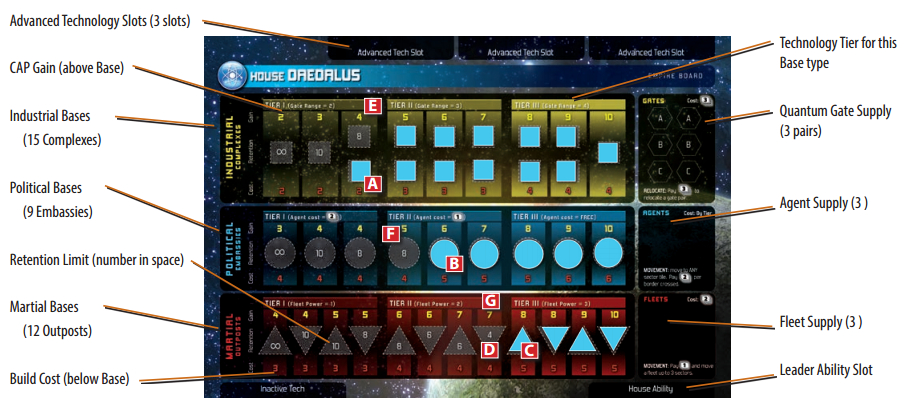
When a player collects CAPs, they take the CAP Gain value that is listed in the columns for their right-most built bases. CAPs are necessary to build, but they can also be used in the game to negotiate peace and cabals with or against opponents. Overall, players shouldn’t have a problem obtaining CAPs. They will have a difficult time determining how best to spend them, however.
Phase 2: Expansion
The second phase, starting with the Arbiter, allows the players to flip over one Sector hex tile from the Sector draw stack, add it to the pool, and then select any face-up Sector hex tile in the pool. The player’s selected Sector hex tile can then be placed on any free space except the center of the Galactic Core (that keeps track of the game’s phases). Each Sector hex tile will have 1, 2, or 3 locations for a base. When a player builds a base in the Sector hex tile, they will obtain power and influential range, which will be used later in the game to expand the player’s empire.
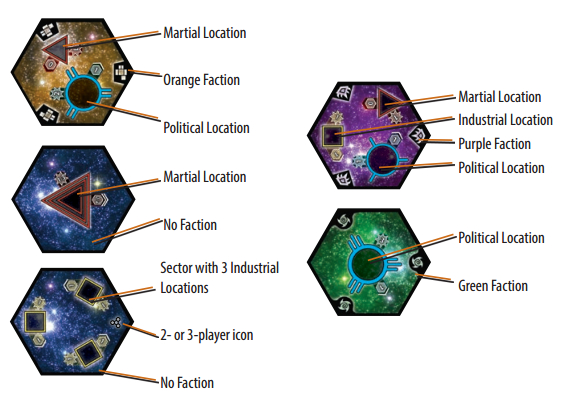
The player then draws 1 Technology card from the Technology draw deck, the top most discarded Technology card, or any currently in play Technology cards the player’s opponents might have. The Technology card is added to the player’s Technology card hand.
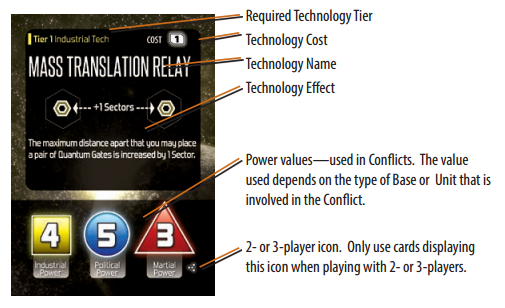
Finally, the player can discard 1 Technology card from their hand to the discard pile or select 1 Technology card they have in their hand and play it to one of their three open Advanced Technology slots found at the top of their Player board. Technology belongs to 1 of 3 possible tiers in the areas of Political, Industrial, and Martial power. The player cannot build a Technology card unless their empire has advanced to that specific tier through expansion (which, again, is tracked on the Player board). Each Technology card also costs the player to bring out, which is paid for in CAPs. Once played, the Technology card’s ability is always available to the player if they own it.
Phases 3, 4, and 5: Actions
The third, fourth, and fifth phase of a round allow the player to take 1 or 2 actions per phase. The actions the player can take will focus on movement, building, collecting additional CAPs, and combat. Each player is given an identical set of Action cards. Each action card will have a number value and 2 or more actions listed.
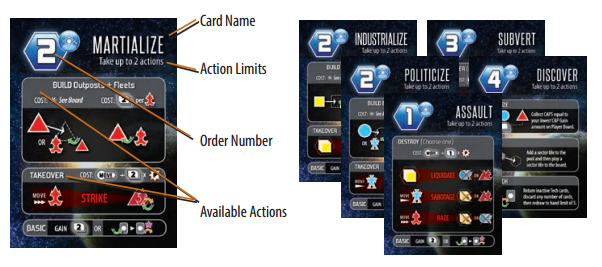 At the start of phase 3, 4, and 5, each player will secretly select 1 of their Action cards and place it face-down. When all the players have placed an Action card, they are revealed and resolved starting with the Action card that has the lowest number. Each player will take 2 actions in any order they like and can repeat the same action, but they are limited to only taking the actions listed on their selected Action card for the phase. Optionally, a player could elect to take 1 or none of the actions. Refer to the rule book for a full description of the actions available.
At the start of phase 3, 4, and 5, each player will secretly select 1 of their Action cards and place it face-down. When all the players have placed an Action card, they are revealed and resolved starting with the Action card that has the lowest number. Each player will take 2 actions in any order they like and can repeat the same action, but they are limited to only taking the actions listed on their selected Action card for the phase. Optionally, a player could elect to take 1 or none of the actions. Refer to the rule book for a full description of the actions available.
All building, movement, and combat is resolved at the time the action is taken. See “Combat and Movement” for further information on these two actions. The cost of building, moving, and fighting is always listed on the Action cards. Once a player completes their actions, the next player in turn order sequence based on the number value of the played Action cards goes. Once all the players have completed their actions, the phase is concluded and all the player reclaim their Action cards. Phases 4 and 5 are repeated in the same way.
Phase 6: Arbitration
The last phase of the round gives the Arbiter token to the player who has the most CAPs. Then all the players reduce their total CAP value in accordance to their Retention Limit noted on their Player board.
Finally, the round is scored. Each player counts the power generated by all their bases built. A number of victory points are then awarded based on how much power the player has in comparison to their opponents, with additional victory points being awarded for having total control over certain boards and the Galactic Core. All victory points are kept track of by using the Score board.
This concludes the round. A new round now begins unless the end game condition has been obtained during the round.
Ending the Game
The game ends after the sixth phase of any round when there are no more Sector hex tiles in the draw stack or all the hex spaces on the boards have been filled. In addition to the points already earned during the round’s sixth phase, the players obtain additional points for their Advanced Technologies. The player with the most victory points wins the game.
Combat and Movement
Movement in Hegemonic is done through power, influence, and proximity. A player must use a specific Action card and may build in any Sector hex tile if they can influence it from adjacent Sector hex tiles they have built bases on. This is done by inspecting the Sector hexes around the Sector hex tile the player wants to build to and seeing how many bases of a specific type (based on the Action card) are in play, as well as how far the specific Sector’s influence (“range”) they provide. Consider influence to be equivalent to the number of spaces away the player can build. Players can use Advanced Technology and Quantum Gates to go further than what they normally would be able to.
Of course, if a player wants to, they can attack a nearby Sector hex tile in hopes of taking it over and removing their opponent through Political, Industrial, and Martial power. Influence still determines if the targeted Sector hex tile is in range. After that, combat is calculated and resolved by completing a small number of sequential steps.
- Determine Conflicting Power: This is done by counting the power of specific bases in range, including Agents and Fleets. Note that combat costs CAPs. If the player cannot pay to initiate combat, they cannot engage an opponent. How big a force the player brings into the fight and the overall power of their target determines how much a siege campaign will cost.
- Add Political Support: Players not included in combat can provide Political power if Political power is being used in combat. Players should feel free to ask for CAP compensation, if they like.
- Add Technology Cards: The Attacker and Defender both select a Technology card from their hand and then reveal it at the same time. At the bottom of each Technology card are 3 different power values that can be added to the total conflicting power of the specific type being used.
- Determine Conflict Outcome: Once all the power has been added up by both sides, the winner is determined. The player who has the higher conflicting power wins. Depending on the Action card used, bases could be removed or replaced.
- Cleanup: Once the boards and bases have been updated, the players either place their used Technology card into their “Inactive Technology pile”, where they will stay until returned to the player’s hand or they can draw a new Technology card (from the draw deck, discard pile, or one currently being used by another player), discarding the Technology card they used during combat.
Game Variants
A number of game variants are available that add even more depth to the game, as well as complexity.
Leader Cards
The players can select a Leader card during game set up that represents their empire’s supreme commander. Leaders provide additional abilities that are unique to each Leader card. This gives their owning player access to abilities their opponents do not have, giving them a reason to explore different tactics and strategies during game play. Leaders also increase their level of power when not in use. Once they are used, their abilities drop to “zero” and the player must wait until the Leader card gains power, which is done once per round.
Multiple Technology Cards
This game variant puts the discarded Technology cards into their different types. The players will have a Political, Industrial, and Martial Technology discard pile. This gives the players a bit more choice and control when building technology for their empire.
Technology Drafting
This game variant changes how the players get their initial Technology cards by using a drafting system during game set up. Each player is given 6 Technology cards. Each player then selects 1 and passes the remaining cards to their opponent to their immediate let. This is repeated a total of 5 times. The last card that is not claimed is placed in the discard pile.
Longer Game
This game variant is only recommended for players who know the game very well, as the game is pretty long as it is. The game’s total length is extended to an additional 1 or 2 rounds by changing how the Sector hex tiles are stacked.
“Wild” Home Embassies
This game variant allows the player’s Home Sector to provide 1 Political power when it normally would not.
To learn more about Hegemonic and read the full rules, visit the game’s web page. I have only summarized the game here and glossed over some of the more detailed and complicated game mechanisms Hegemonic has to offer.
Prediction
After reading the rule book for Hegemonic, I have some serious doubts if I can teach it to our Child Geeks and our casual game playing Parent Geeks. Hegemonic is a difficult game to grasp, but the specific phases are very focused, which should allow me to break down the game into easier to manage topic areas. The biggest area of concern are the Action phases, as that is where the game really takes place. I can teach to our players what all the actions do on the game board, but not what they necessarily accomplish in the long run. Players need to have a pretty good idea about what their strategy is and then play the game using as many tactics as possible to ensure their strategy stays on course. Hegemonic is as close to a zero-luck game as you get, minus the random card and hex tile draws. That means players will have a lot of information in front of them. I can teach them what it means, but it will be up to them to put it into a meaningful and actionable context.
For our Child and Parent Geeks, we’ll be lucky if we can finish a game, let alone 2 or more. Hegemonic would appear to be a game that takes a long time to complete. New players are not going to play the game quickly, even if they are well seasoned gamers. With an estimated 45 minutes of game play time per player, we’re looking at a game that could take over 2 hours…perhaps even 3. That’s more time than most Parent Geeks can provide or Child Geeks can tolerate. As for the Gamer Geeks, Hegemonic is being positioned as a 4X game, which means the game focuses on exploring, expanding, exploiting, and extermination. The exploring portion doesn’t appear to be all that exciting, as the tiles available to the players are clearly visible, but that does allow the players to make better choices for their expanding and exploiting. The extermination portion (combat) is a numbers game to the extreme. Pretty mathy and will cause the game play to really slow down until all the players are familiar with the game play.
My prediction is pretty simple: Hegemonic will be well received by the Gamer Geeks, mixed at best with the Parent Geeks, and disliked by the Child Geeks.
It took me 3 evenings to walk my oldest Child Geek through Hegemonic. By the third evening, he was ready to call it quits. He was clearly tired of “talking about it” and just wanted to get into the game. And so, after I relented and we set up the game, I asked him his thoughts on Hegemonic so far.
“The game sounds big, but a player’s turn doesn’t. I know exactly what I can do and with what based on the cards. That’s all I should need to know to play, right?” ~ Liam (age 9)
Technically, yes, but in order to be a cardiac surgeon you need to know more than just the location of the heart. That is to say, the game is more than just completing the phases in sequential order. The game’s depth is pretty – well – deep. You could, feasibly, just build and go, but you’ll hit the proverbial brick wall pretty hard when you come up against a player who is taking into account more than just what can be accomplished per round. Let’s play Hegemonic and see if it blows us out of this world or just blows us up.
Final Word
The Child Geeks did not care for Hegemonic. They found it to be too long and too confusing most of the time. Combat was the final nail in this coffin. The Child Geeks couldn’t keep all the different bonuses and ranges in mind when they attempted to make their move. Only the oldest of our Child Geek players grasped enough of the game to play it, but not confidently. According to one Child Geek, ‘There is just too much game to this game.” Ha! Well put! The Action cards, Technology cards, and all the rest added up to a game that was simply too much for the Child Geeks to appreciate. As such, it was rejected by the Child Geeks and quickly forgotten.
The Parent Geeks didn’t care for the game either. Despite its relatively smooth game play, the game’s length simply tired them out. There is a great deal to contemplate and the abstract nature of the game had our players constantly scanning the game board again and again in attempt to connect the galactic dots. According to one Parent Geek, “I see a good game here, but there is too much going on for me to get a good grasp on it.” Most of the Parent Geeks agreed that Hegemonic was a good game, but not one they had the time or patience for. Only the most diehard of the Parent Geeks (who I would consider borderline Gamer Geeks) thought that Hegemonic was a “good mix of complexity and fun.” The majority, however, voted it down resulting in Hegemonic getting rejected by the Parent Geek group.
The Gamer Geeks were surprisingly mixed. For those who enjoyed a good 4X game experience, they found Hegemonic strangely lacking. According to one Gamer Geek, “There is no exploration here. I know exactly what I am placing and what will be there. Combat is a mess and I feel like I am playing Hopscotch across the galaxy. I don’t feel like I’m fighting space battles, participating in political espionage, or crippling civilizations with my industrial might. What I do feel is bored. I mean, I can’t even remove a player from the game because their Home Sector is magically secure from all attacks!” Another Gamer Geek who rather enjoyed Hegemonic said, “This is a great abstract game. Combat is calculated, worker placement is meaningful, and strategic area control is a must in hopes of obtaining victory. The Technology helps improve game play without breaking it and I love how I can chain my actions to have a real impact to the overall game play. Great game!” The line dividing our Gamer Geeks was clearly drawn. On one side were the Sci-Fi enthusiasts who liked big ships, epic space battles, exploration, and conquering. On the other side were the strategic abstract board game lovers who enjoyed watching their game evolve and change subtly over a long period of time, where tactical movement was done over periods of turns, and the game speed was fast enough to keep the game going, but slow enough to allow for deep decision making. In the middle were those players who thought that Hegemonic was simply “OK”.
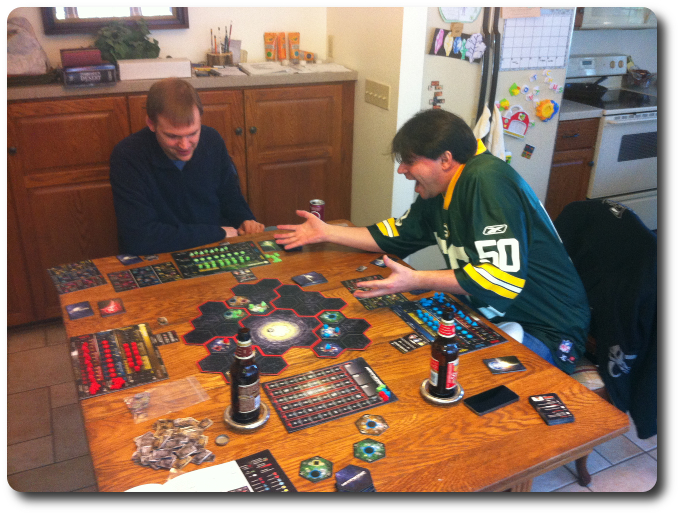
The Gamer Geeks debate the pros and cons of the game
I was one of those Gamer Geek who were in the middle. I like a good abstract board game, which Hegemonic certainly is, but I also want to see lots of space ships cross the game board and swarm a planet. Hegemonic provides a gaming experience that allows for large-scale battles, but the action is played out mathematically instead of thematically. The overall game feels like it wants to be about space conquest and empire building, but falls just short of doing so. The game’s abstract nature holds it back a bit, but it’s also the abstract nature of the game that I enjoy. I like seeing my Political, Industrial, and Martial power creep across the galaxy. Getting just the right power and influence in one spot at the right time allowed me to “backdoor” an opponent and sweep in through a zone that I quickly took over. That felt very satisfying, but my personal level of excitement over the game never went any further than simply being satisfied. The game neither overly excited me or disappointing me.
Hegemonic is a gamer’s game. It can be downright difficult and feel bulky at times with so much on the table to consider. This is especially true when combat gets going during the last half of the game. There is a lot to calculate when moving in, adding power and influence, getting others to help, and then doing last-minute adjustments. For a Gamer Geek, this is a cakewalk, but it’s still pretty time-consuming. But this is the price we must pay if the game removes all elements of luck from its game play. Every point of power and influence is calculated by adding up number values. No roll of the dice or random card draw will bring a sector down. A player can calculate their odds of winning by simply determining if their numbers are higher than their opponent’s. That puts a lot of control in the player’s lap, but it also causes the game to be slower. Not a big deal to most Gamer Geeks, but there is only so much downtime between combat and taking turns any player can tolerate. In the end, what made a player fall in love with the game or not was their personal likes and dislikes. Which, as we know, is a highly subjective process.
Hegemonic will challenge you, make no mistake. The question is, are you up for it?
This game was given to Father Geek as a review copy. Father Geek was not paid, bribed, wined, dined, or threatened in vain hopes of influencing this review. Such is the statuesque and legendary integrity of Father Geek.




Thanks for the extensive summary of the rules and play experience. Given the recommended age range and complexity of the game, too much time and negative commentary was spent on teaching the game to a younger child, however. The review comes across entirely too harsh in that regard and somewhat ridiculous for spending so much time trying.
If you were to teach a younger child or a non-gamer, a demo playthrough with instruction on the actions to take and the reasoning behind the choices would be a much more effective approach than talking for days.
The review would have been great, except that the overbearing negative tone, coupled with the incessant critical beating of the proverbial dead horse into the ground, was just too much. Given the target audience of the blog, why even bother to review the game?
Thanks for taking the time to leave a comment.
Wow, clearly Icarus has no idea what it is you do, Father Geek.
Hey, Icarus, see the website’s tag line? Yeah, good job, Sherlock. Next time you go making a fan-boy statement that is obviously geek-rage related, try to do your homework first. And, oh, guess what, not everyone thinks the way you do. Yeah, I know, hard for your ego to take, I’m sure.
I played Hegemonic and I thought it was so-so. ECLIPSE IS SO MUCH FREAKING BETTER!
For anyone who spent money on the Kickstarter, enjoy your so-so game. You paid for it. Don’t get all pissed off because someone tried to play the game with their kids and nongamer and – OH SHIT GUESS WHAT?! – it didn’t work. Are you surprised? Really? Idiots…
But that’s not what Father Geek is focusing on. Or, rather, he is simply reporting that which he tried and failed to accomplish. Why are you bashing him for doing what you could not? What a dick…
GOOD ON YOU, FATHER GEEK! You are trying to play games with your kids which is a HELL OF A LOT MORE than lots of dads do today.
Everyone has a right to express their opinion, Tim. Icarus is expressing his. Either accept it or reject it. There is no need for name calling or aggressive behavior. I celebrate diversity and uniqueness in all forms. I appreciate it when people don’t agree with me, because that means they are thinking for themselves. That is something that should be applauded, not attacked.
Let us also keep in mind that we are only talking about a game here. Keep things in perspective, please.
Not a fan boy of Hegemonic, Tim. You seem to be a Father Geek fan boy, though, given the tone of your response.
Actually, on the mobile version of the site that I am viewing, there is no tag line above this article.
I considered the review to be excessively negative in tone, and reflective of unrealistic expectations for the game, that is all.
Not interested in a flame war, so feel free to take the last word on this.
You got it, Kiddo. Good for you for knowing when to back down.
(facepalm)
Don’t go losing your cool over a box full of cardboard and plastic, gents.
ps I am an occasional reader of this site, and generally enjoy the reviews. Though sometimes they can go a bit off the rails when reiterating negative points. The depth of Hegemonic appears to have exaggerated that tendency a bit. Looking forward to your next review. Thanks!
Thank you very much for taking the time to read our reviews and to leave a comment, Icarus. Despite what some might suggest, your time and opinion is important to us.
I think the main point to remember here, is that Hegemonic isn’t aimed at a younger, or even casual audience. This IS a meaty, bulky game. Love your reviews, Cyrus. There is a great game here, but definitely not with a mixed group of gamers. I would no more bring this to the table with children, than I would Arkham Horror, or Merchants and Marauders. Too much going on, and you end up playing for several people.
Pingback: Today in Board Games Issue #97 - Today in Board Games